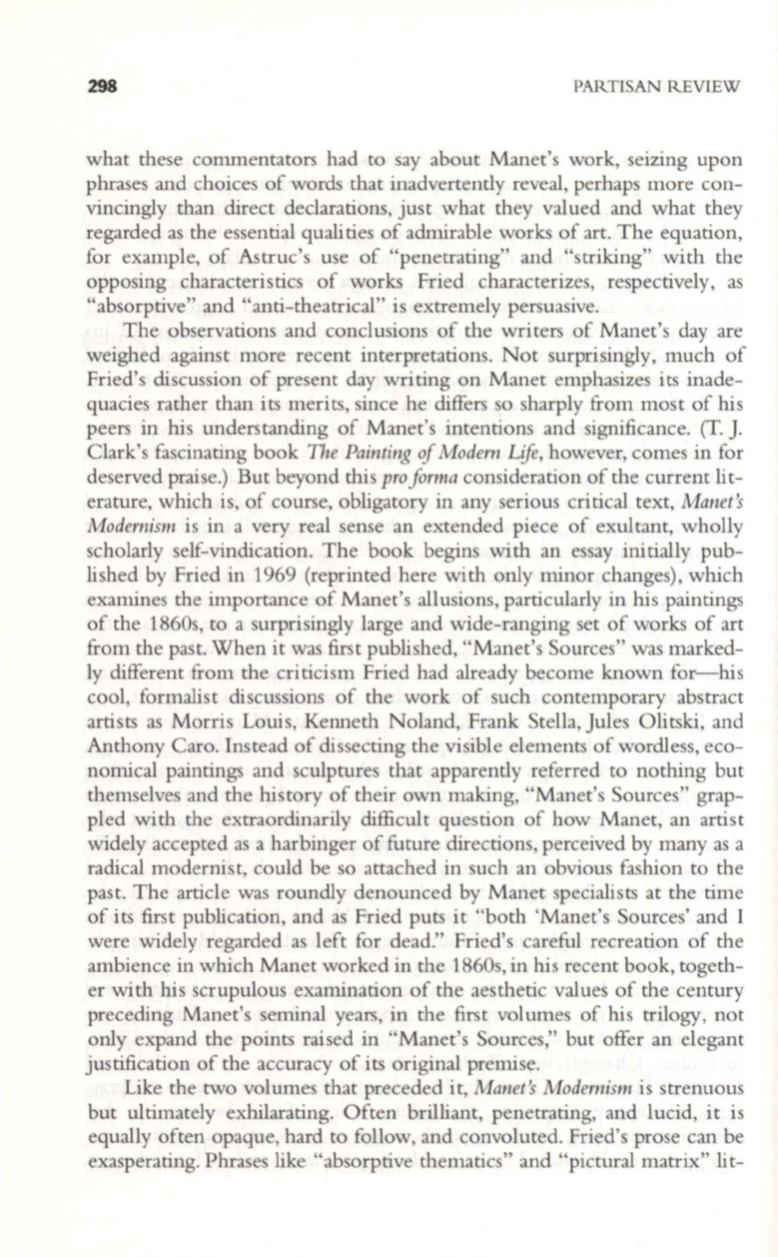
298
PARTISAN REVIEW
what these commentators had to say about Manet's work, seizing upon
phrases and choices of words that inadvertently reveal, perhaps more con–
vincingly than direct declarations, just what they valued and what they
regarded as the essential qualities of admirable works of art. The equation,
for example, of Astruc's use of "penetrating" and "striking" with the
opposing characteristics of works Fried characterizes, respectively, as
"absorptive" and "anti-theatrical" is extremely persuasive.
The observations and conclusions of the writers of Manet's day are
weighed against more recent interpretations. Not surprisingly, much of
Fried's discussion of present day writing on Manet emphasizes its inade–
quacies rather than its merits, since he differs so sharply from most of his
peers in his understanding of Manet's intentions and significance.
(T.
J.
Clark's fascinating book
The Painting
of
Modern Life,
however, comes in for
deserved praise.) But beyond this
pro forma
consideration of the current lit–
erature, which is, of course, obligatory in any serious critical text,
Manet's
Modernism
is in a very real sense an extended piece of exultant, wholly
scholarly self-vindication. The book begins with an essay initially pub–
lished by Fried in 1969 (reprinted here with only minor changes), which
examines the importance of Manet's allusions, particularly in his paintings
of the 1860s, to a surprisingly large and wide-ranging set of works of art
from the past. When it was first published, "Manet's Sources" was marked–
ly different from the criticism Fried had already become known for-his
cool, formalist discussions of the work of such contemporary abstract
artists as Morris Louis, Kenneth Noland, Frank Stella, Jules Olitski, and
Anthony Caro. Instead of dissecting the visible elements of wordless, eco–
nomical paintings and sculptures that apparently referred to nothing but
themselves and the history of their own making, "Manet's Sources" grap–
pled with the extraordinarily difficult question of how Manet, an artist
widely accepted as a harbinger of future directions, perceived by many as a
radical modernist, could be so attached in such an obvious fashion to the
past. The article was roundly denounced by Manet specialists at the time
of its first publication, and as Fried puts it "both 'Manet's Sources' and I
were widely regarded as left for dead." Fried's careful recreation of the
ambience in which Manet worked in the 1860s, in his recent book, togeth–
er with his scrupulous examination of the aesthetic values of the century
preceding Manet's seminal years, in the first volumes of his trilogy, not
only expand the points raised in "Manet's Sources," but offer an elegant
justification of the accuracy of its original premise.
Like the two volumes that preceded it,
Manet's Modernism
is strenuous
but ultimately exhilarating. Often brilliant, penetrating, and lucid, it is
equally often opaque, hard to follow, and convoluted. Fried's prose can be
exasperating. Phrases like "absorptive thematics" and "pictural matrix" lit-


